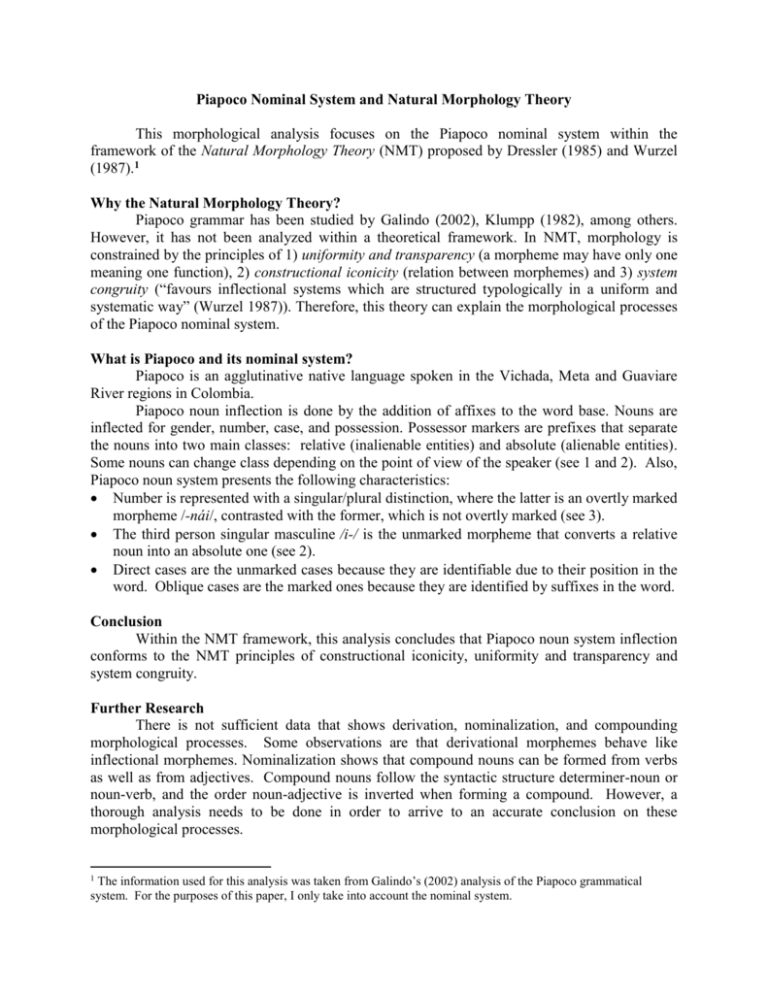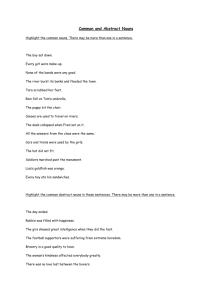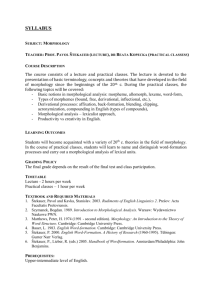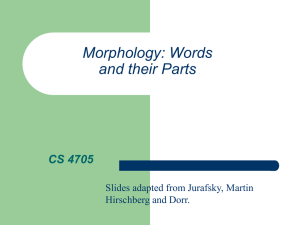Piapoco Nominal System and Natural Morphology Theory
advertisement

Piapoco Nominal System and Natural Morphology Theory This morphological analysis focuses on the Piapoco nominal system within the framework of the Natural Morphology Theory (NMT) proposed by Dressler (1985) and Wurzel (1987).1 Why the Natural Morphology Theory? Piapoco grammar has been studied by Galindo (2002), Klumpp (1982), among others. However, it has not been analyzed within a theoretical framework. In NMT, morphology is constrained by the principles of 1) uniformity and transparency (a morpheme may have only one meaning one function), 2) constructional iconicity (relation between morphemes) and 3) system congruity (“favours inflectional systems which are structured typologically in a uniform and systematic way” (Wurzel 1987)). Therefore, this theory can explain the morphological processes of the Piapoco nominal system. What is Piapoco and its nominal system? Piapoco is an agglutinative native language spoken in the Vichada, Meta and Guaviare River regions in Colombia. Piapoco noun inflection is done by the addition of affixes to the word base. Nouns are inflected for gender, number, case, and possession. Possessor markers are prefixes that separate the nouns into two main classes: relative (inalienable entities) and absolute (alienable entities). Some nouns can change class depending on the point of view of the speaker (see 1 and 2). Also, Piapoco noun system presents the following characteristics: Number is represented with a singular/plural distinction, where the latter is an overtly marked morpheme /-nái/, contrasted with the former, which is not overtly marked (see 3). The third person singular masculine /i-/ is the unmarked morpheme that converts a relative noun into an absolute one (see 2). Direct cases are the unmarked cases because they are identifiable due to their position in the word. Oblique cases are the marked ones because they are identified by suffixes in the word. Conclusion Within the NMT framework, this analysis concludes that Piapoco noun system inflection conforms to the NMT principles of constructional iconicity, uniformity and transparency and system congruity. Further Research There is not sufficient data that shows derivation, nominalization, and compounding morphological processes. Some observations are that derivational morphemes behave like inflectional morphemes. Nominalization shows that compound nouns can be formed from verbs as well as from adjectives. Compound nouns follow the syntactic structure determiner-noun or noun-verb, and the order noun-adjective is inverted when forming a compound. However, a thorough analysis needs to be done in order to arrive to an accurate conclusion on these morphological processes. The information used for this analysis was taken from Galindo’s (2002) analysis of the Piapoco grammatical system. For the purposes of this paper, I only take into account the nominal system. 1 Selected Data 1) Absolute objects of daily use are considered inalienable by the speaker. For this change of class, it is necessary to use the genitive /-a:qu/:2 Antonio ya:u tsipari /Antonio ya:qu tsipari/ Antonio 3SG.M-GEN axe ‘Antonio’s axe” 2) Some relative nouns (only parts of the body) can become absolute nouns by neutralizing the possessive prefix into a 3SG.M plus the autonomy suffix /-i/: Nukutzúi → ikutzúizi /nu-kutsúi/ /ikutsúi-i/ 1SG-knee 3SG.M-knee- AUTON ‘my knee’ ‘knee’ (3) tzamananái /tzamana-nái/ alligator- PL ‘alligators’ Selected References Dressler, W.U. (1985). On the Predictiveness of Natural Morphology. Journal of Linguistics, 21, p. 321-338. Dressler, W.U., Wurzel, W., et al. (1987). Leitmotifs in Natural Morphology. Studies in Language Companion Series, 10. Philadelphia: John Benjamins Publishing Company Galindo, A. E. (2002). Elementos para una Gramática de la Lengua Piapoco. Colombia: Ministerio de la Cultura Klumpp, D. A. (1982). La Palabra Fonológica en Piapoco. Artículos en Lingüística y Campos Afines, 11:83-98. 2 The notations used for Piapoco are: 1 = first person, 3 = third person, AUTON = autonomizer, GEN = genitive, M = masculine, PL = plural, SG = singular.











